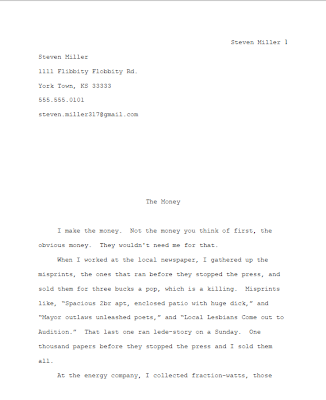
Now here is the main event. As you all have been anxiously awaiting this entry, I will skip the introductions!
When reviewing a manuscript, a writer should break it down into three aspects: (a) formatting, (b) copy editing, and (c) labeling. This is, at least, how I review my manuscripts.
(a) Formatting
This is simple enough, but can be a big deal to editors. I like to set up my page first: Margins 1", page format Letter (8.5" x 11"), and then a standard heading. Next I Select-All (ctrl+A) my story and change the font to Courier New 12 pt. I do this so that I can better copy edit it later and so that it won't hurt the editor's eyes. Courier New is a monotype font, which means that each letter takes up the same width. A font like Times New Roman may look professional, but it's actually very hard to proof read, because some letters (i's and t's and l's in particular) end up jammed together. I also go into "Page" and set the paragraphs to double-spaced.
Next, I add the page number into the heading, which is found under "Insert" in most word processors. I also, write in my full name, making sure to change the front to match the manuscript. This is technically part of (c) labeling, but I'll include it here.
For each new paragraph I make sure to tab the first word 1/2" from the left margin. If there's a substantial span of narrative time I put an extra space between the two paragraphs, and center a "#" in the line between them.
Next, I "Save As" as a doc file, so that editors with any Microsoft Word or Open Office or most other word processors can open it.
(b) Copy Editing
Here we are simply making sure everything is spelled correctly, punctuated, etc. I like to print my manuscript and run through it with a blue, fine-tipped marker. You can also give it to a friend, as an extra set of eyes can do wonders in this particular area.
(c) Labeling
All I mean here is that your name is displayed on the manuscript. If you don't put your full name on each page, the manuscript might come apart and the editors wouldn't know whose wonderful work they're reading!
I like to put my information - Full Name, Address, Email Address, Phone Number - in the upper left corner of page one.
Making sure your manuscript is legible is the first step in not being ruled out. Many editors are looking for an excuse to not accept your work. Don't let them have an easy one!